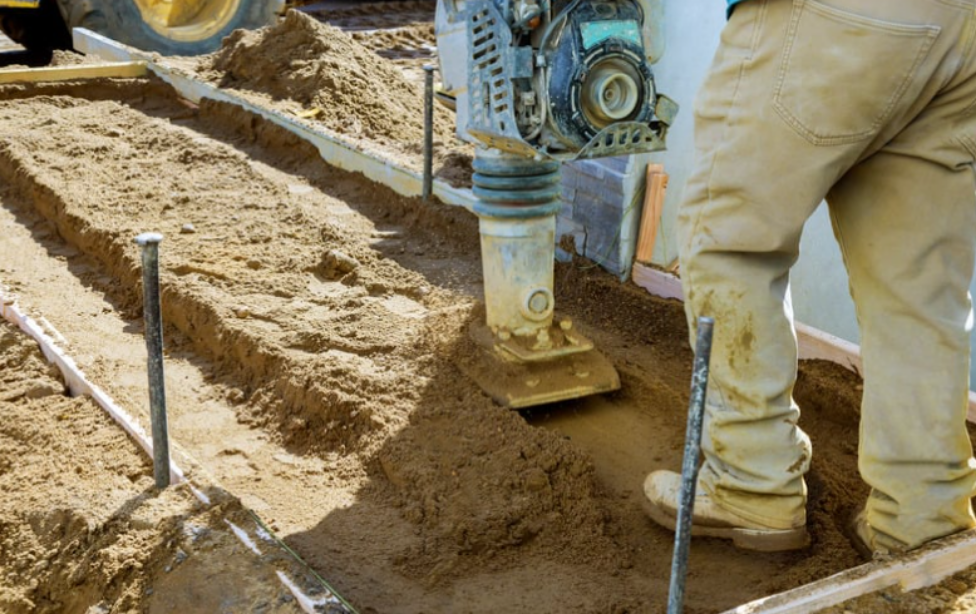
When it comes to building strong, long-lasting concrete floors, surface preparation is everything. If you don’t start with a properly compacted base, you’re just asking for trouble—think cracks, uneven surfaces, and costly repairs down the line. That’s where rammers, plate compactors, and rollers come into play. These hardworking machines are the backbone of compaction, ensuring a stable foundation for concrete work, road construction, and more.
So, which one should you use? Let’s break it down and explore the specific roles of each type of compaction equipment.
Rammers: The Tight-Space Specialist
Ever tried compacting soil in a narrow trench with a massive machine? It’s not happening! That’s why we have rammers—powerful, upright machines designed for compacting cohesive soils like clay in tight spaces.
When to Use a Rammer
- Trenches and small areas – Perfect for prepping the ground before laying foundations, pipes, or retaining walls.
- Cohesive soils – If your job site has high-clay content, a rammer’s high-impact force will get the job done.
- Repair work – Great for fixing patches of soil or asphalt without needing large equipment.
Rammers work by delivering a pounding action, driving out air pockets and ensuring a solid, stable base. Think of them as the jackhammers of compaction, giving you deep and focused power where you need it most.
Plate Compactors: The Versatile Workhorse
If rammers are great for small areas, plate compactors are the perfect middle ground, and are versatile and easy to maneuver for a range of surface prep jobs. These machines feature a heavy steel plate that vibrates rapidly, helping compact soil, sand, or gravel quickly and evenly.
When to Use a Plate Compactor
- Driveways, patios, and sidewalks – Ideal for prepping the ground before laying concrete or pavers.
- Granular soils – Works best on materials like sand, gravel, and crushed stone.
- Tight to medium-sized spaces – Not as bulky as rollers but more efficient than rammers for open areas.
A forward plate compactor is great for standard jobs, but if you need extra power and efficiency, consider a reversible plate compactor—which moves in both directions for deeper compaction.
Walk-Behind Rollers: The Step Up in Compaction
Need something bigger than a plate compactor but not quite as massive as a ride-on roller? Walk-behind rollers are your answer. These compact, easy-to-control machines deliver more force than a plate compactor while still being maneuverable enough for smaller spaces.
When to Use a Walk-Behind Roller
- Small to medium-sized jobs – Parking lots, bike paths, and small roadways benefit from their efficient compaction.
- Compacting asphalt – Perfect for smoothing out freshly laid asphalt or patchwork.
- Soil and gravel prep – Great for compacting bases before pouring concrete.
Ride-On Rollers: The Big Job Beast
For large-scale compaction, nothing beats a ride-on roller. These heavy-duty machines use weight and vibration to compact huge areas quickly and efficiently. Whether you’re working on roads, highways, or industrial floors, a ride-on roller is the ultimate tool for maximum stability.
When to Use a Ride-On Roller
- Major roadwork and highways – These machines ensure smooth, even surfaces across large areas.
- Large concrete slabs – Need a strong base for a warehouse floor? A ride-on roller gets it done.
- Massive compaction jobs – When speed and deep compaction matter, this is the machine for the job.
Why Proper Compaction is Non-Negotiable
Skipping proper compaction might save a little time upfront, but it’s a recipe for disaster. Poorly compacted soil leads to:
Cracking concrete – If the base shifts over time, your concrete will too.
Uneven floors – A weak foundation can result in sinking or bumpy surfaces.
Water drainage problems – Loose soil allows water to collect, causing erosion and instability.
Using the right equipment ensures your concrete foundation stays strong and durable, avoiding costly repairs later on.
Choosing the Right Equipment for Your Project
So, which one do you need? It all depends on your project size and soil type:
✔ Use a rammer for small, tight spaces and compacting cohesive soils.
✔ Use a plate compactor for driveways, patios, and granular soil.
✔ Use a walk-behind roller for small to medium-sized areas needing extra compaction.
✔ Use a ride-on roller for large-scale projects requiring deep, even compaction.
With the right concrete finishing tools from All States Africa, you can save time, and energy, and avoid unnecessary frustration. Whether you’re a contractor or tackling a DIY project, we’ve got the equipment and expertise to help you achieve professional results. Let us supply the tools you need to turn your vision into reality—smoothly and efficiently. Contact us today!
